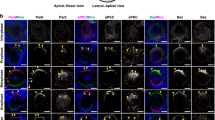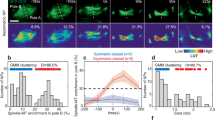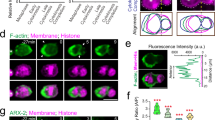Abstract
Polarization of a neuron begins with the appearance of the first neurite, thus defining the ultimate growth axis. Unlike late occurring polarity events (such as axonal growth), very little is known about this fundamental process. We show here that, in Drosophila melanogaster neurons in vivo, the first membrane deformation occurred 3.6 min after precursor division. Clustering of adhesion complex components (Bazooka (Par-3), cadherin–catenin) marked this place by 2.8 min after division; the upstream phosphatidylinositol 4,5-bisphosphate, by 0.7 min after division; and the furrow components RhoA and Aurora kinase, from the time of cytokinesis. Local DE-cadherin inactivation prevented sprout formation, whereas perturbation of division orientation did not alter polarization from the cytokinesis pole. This is, to our knowledge, the first molecular study of initial neuronal polarization in vivo. The mechanisms of polarization seem to be defined at the precursor stage.
This is a preview of subscription content, access via your institution
Access options
Subscribe to this journal
Receive 12 print issues and online access
$209.00 per year
only $17.42 per issue
Buy this article
- Purchase on Springer Link
- Instant access to full article PDF
Prices may be subject to local taxes which are calculated during checkout







Similar content being viewed by others
References
St. Johnston, D. & Ahringer, J. Cell polarity in eggs and epithelia: parallels and diversity. Cell 141, 757–774 (2010).
Gao, L. & Bretscher, A. Polarized growth in budding yeast in the absence of a localized formin. Mol. Biol. Cell 20, 2540–2548 (2009).
Ridley, A.J. et al. Cell migration: integrating signals from front to back. Science 302, 1704–1709 (2003).
McGill, M.A., McKinley, R.F. & Harris, T.J. Independent cadherin-catenin and Bazooka clusters interact to assemble adherens junctions. J. Cell Biol. 185, 787–796 (2009).
Tahirovic, S. & Bradke, F. Neuronal polarity. Cold Spring Harb. Perspect. Biol. 1, a001644 (2009).
Menchón, S.A., Gärtner, A., Román, P. & Dotti, C.G. Neuronal (bi)polarity as a self-organized process enhanced by growing membrane. PLoS ONE 6, e24190 (2011).
Calderon de Anda, F., Gartner, A., Tsai, L.H. & Dotti, C.G. Pyramidal neuron polarity axis is defined at the bipolar stage. J. Cell Sci. 121, 178–185 (2008).
de Anda, F.C. et al. Centrosome localization determines neuronal polarity. Nature 436, 704–708 (2005).
Noctor, S.C., Martinez-Cerdeno, V., Ivic, L. & Kriegstein, A.R. Cortical neurons arise in symmetric and asymmetric division zones and migrate through specific phases. Nat. Neurosci. 7, 136–144 (2004).
Basto, R. et al. Flies without centrioles. Cell 125, 1375–1386 (2006).
Peel, N., Stevens, N.R., Basto, R. & Raff, J.W. Overexpressing centriole-replication proteins in vivo induces centriole overduplication and de novo formation. Curr. Biol. 17, 834–843 (2007).
Gho, M., Bellaiche, Y. & Schweisguth, F. Revisiting the Drosophila microchaete lineage: a novel intrinsically asymmetric cell division generates a glial cell. Development 126, 3573–3584 (1999).
Keil, T.A. Functional morphology of insect mechanoreceptors. Microsc. Res. Tech. 39, 506–531 (1997).
Hartenstein, V. & Posakony, J.W. Development of adult sensilla on the wing and notum of Drosophila melanogaster. Development 107, 389–405 (1989).
Emery, G. et al. Asymmetric Rab 11 endosomes regulate delta recycling and specify cell fate in the Drosophila nervous system. Cell 122, 763–773 (2005).
Rolls, M.M. et al. Polarity and intracellular compartmentalization of Drosophila neurons. Neural Develop. 2, 7 (2007).
Varmark, H. et al. Asterless is a centriolar protein required for centrosome function and embryo development in Drosophila. Curr. Biol. 17, 1735–1745 (2007).
Kakihara, K., Shinmyozu, K., Kato, K., Wada, H. & Hayashi, S. Conversion of plasma membrane topology during epithelial tube connection requires Arf-like 3 small GTPase in Drosophila. Mech. Dev. 125, 325–336 (2008).
Kondylis, V., Spoorendonk, K.M. & Rabouille, C. dGRASP localization and function in the early exocytic pathway in Drosophila S2 cells. Mol. Biol. Cell 16, 4061–4072 (2005).
Barnes, A.P. & Polleux, F. Establishment of axon-dendrite polarity in developing neurons. Annu. Rev. Neurosci. 32, 347–381 (2009).
Dupin, I., Camand, E. & Etienne-Manneville, S. Classical cadherins control nucleus and centrosome position and cell polarity. J. Cell Biol. 185, 779–786 (2009).
Oda, H., Uemura, T., Harada, Y., Iwai, Y. & Takeichi, M. A Drosophila homolog of cadherin associated with armadillo and essential for embryonic cell-cell adhesion. Dev. Biol. 165, 716–726 (1994).
Yonemura, S., Wada, Y., Watanabe, T., Nagafuchi, A. & Shibata, M. alpha-Catenin as a tension transducer that induces adherens junction development. Nat. Cell Biol. 12, 533–542 (2010).
Lu, B., Rothenberg, M., Jan, L.Y. & Jan, Y.N. Partner of Numb colocalizes with Numb during mitosis and directs Numb asymmetric localization in Drosophila neural and muscle progenitors. Cell 95, 225–235 (1998).
Rieger, S., Senghaas, N., Walch, A. & Koster, R.W. Cadherin-2 controls directional chain migration of cerebellar granule neurons. PLoS Biol. 7, e1000240 (2009).
Krahn, M.P., Klopfenstein, D.R., Fischer, N. & Wodarz, A. Membrane targeting of Bazooka/PAR-3 is mediated by direct binding to phosphoinositide lipids. Curr. Biol. 20, 636–642 (2010).
Stauffer, T.P., Ahn, S. & Meyer, T. Receptor-induced transient reduction in plasma membrane PtdIns(4,5)P2 concentration monitored in living cells. Curr. Biol. 8, 343–346 (1998).
Oda, H. & Tsukita, S. Nonchordate classic cadherins have a structurally and functionally unique domain that is absent from chordate classic cadherins. Dev. Biol. 216, 406–422 (1999).
Huang, J., Zhou, W., Dong, W., Watson, A.M. & Hong, Y. From the Cover: Directed, efficient, and versatile modifications of the Drosophila genome by genomic engineering. Proc. Natl. Acad. Sci. USA 106, 8284–8289 (2009).
Monier, B., Pelissier-Monier, A., Brand, A.H. & Sanson, B. An actomyosin-based barrier inhibits cell mixing at compartmental boundaries in Drosophila embryos. Nat. Cell Biol. 12, 60–65 (2010).
Field, S.J. et al. PtdIns(4,5)P2 functions at the cleavage furrow during cytokinesis. Curr. Biol. 15, 1407–1412 (2005).
Wong, R. et al. PIP2 hydrolysis and calcium release are required for cytokinesis in Drosophila spermatocytes. Curr. Biol. 15, 1401–1406 (2005).
Emoto, K., Inadome, H., Kanaho, Y., Narumiya, S. & Umeda, M. Local change in phospholipid composition at the cleavage furrow is essential for completion of cytokinesis. J. Biol. Chem. 280, 37901–37907 (2005).
Piekny, A., Werner, M. & Glotzer, M. Cytokinesis: welcome to the Rho zone. Trends Cell Biol. 15, 651–658 (2005).
Lecuit, T. & Lenne, P.F. Cell surface mechanics and the control of cell shape, tissue patterns and morphogenesis. Nat. Rev. Mol. Cell Biol. 8, 633–644 (2007).
Sahai, E. & Marshall, C.J. ROCK and Dia have opposing effects on adherens junctions downstream of Rho. Nat. Cell Biol. 4, 408–415 (2002).
Yamada, S. & Nelson, W.J. Localized zones of Rho and Rac activities drive initiation and expansion of epithelial cell-cell adhesion. J. Cell Biol. 178, 517–527 (2007).
Berdnik, D. & Knoblich, J.A. Drosophila Aurora-A is required for centrosome maturation and actin-dependent asymmetric protein localization during mitosis. Curr. Biol. 12, 640–647 (2002).
Carmena, M. & Earnshaw, W.C. The cellular geography of aurora kinases. Nat. Rev. Mol. Cell Biol. 4, 842–854 (2003).
Mori, D. et al. An essential role of the aPKC-Aurora A-NDEL1 pathway in neurite elongation by modulation of microtubule dynamics. Nat. Cell Biol. 11, 1057–1068 (2009).
Khazaei, M.R. & Puschel, A.W. Phosphorylation of the par polarity complex protein Par3 at serine 962 is mediated by aurora a and regulates its function in neuronal polarity. J. Biol. Chem. 284, 33571–33579 (2009).
Gho, M. & Schweisguth, F. Frizzled signalling controls orientation of asymmetric sense organ precursor cell divisions in Drosophila. Nature 393, 178–181 (1998).
Hu, C.K., Coughlin, M., Field, C.M. & Mitchison, T.J. Cell polarization during monopolar cytokinesis. J. Cell Biol. 181, 195–202 (2008).
Gervais, L., Claret, S., Januschke, J., Roth, S. & Guichet, A. PIP5K-dependent production of PIP2 sustains microtubule organization to establish polarized transport in the Drosophila oocyte. Development 135, 3829–3838 (2008).
Krummel, M.F. & Macara, I. Maintenance and modulation of T cell polarity. Nat. Immunol. 7, 1143–1149 (2006).
Ling, K., Schill, N.J., Wagoner, M.P., Sun, Y. & Anderson, R.A. Movin′ on up: the role of PtdIns(4,5)P(2) in cell migration. Trends Cell Biol. 16, 276–284 (2006).
Nelson, W.J. Adaptation of core mechanisms to generate cell polarity. Nature 422, 766–774 (2003).
Chong, L.D., Traynor-Kaplan, A., Bokoch, G.M. & Schwartz, M.A. The small GTP-binding protein Rho regulates a phosphatidylinositol 4-phosphate 5-kinase in mammalian cells. Cell 79, 507–513 (1994).
Wu, H. et al. PDZ domains of Par-3 as potential phosphoinositide signaling integrators. Mol. Cell 28, 886–898 (2007).
Gho, M., Lecourtois, M., Geraud, G., Posakony, J.W. & Schweisguth, F. Subcellular localization of Suppressor of Hairless in Drosophila sense organ cells during Notch signalling. Development 122, 1673–1682 (1996).
Acknowledgements
We would like to thank C. Gonzalez, F. Calderon de Anda, A. Gärtner and F. Feiguin for discussions; M. Morgan for technical help and discussions; T. Lecuit and R. Levayer for sharing their adapted CALI protocol; and Y. Bellaiche (Curie Institute), H. Bellen (Baylor College of Medicine), C. Gonzalez (Institut de Recerca Biomedica, Barcelona), T.J.C. Harris (University of Toronto), S. Hayashi (RIKEN Center for Developmental Biology), Y. Hong (University of Pittsburgh), J. Knoblich (Institute of Molecular Biotechnology, Wien), H. Oda (JT Biohistory Research Hall, Takatsuki), M. Rolls (Pennsylvania State University), the Bloomington Drosophila Stock Center and the Developmental Studies Hybridoma Bank for providing us with stocks and reagents. G.P. was supported by a Boehringer Ingelheim Foundation scholarship. This work was supported by Katholieke Universiteit Leuven and Fonds Wetenschappelijk Onderzook-Vlaanderen.
Author information
Authors and Affiliations
Contributions
G.P.: experimental design, data collection and assembly, data interpretation, manuscript writing. J.G.S.: experimental design, data assembly and interpretation, manuscript writing. S.M.: technical and imaging assistance, data analysis. C.G.D.: leading and coordinating the project, manuscript writing and editing. J.G.S. and C.G.D.: supervision of the project.
Corresponding authors
Ethics declarations
Competing interests
The authors declare no competing financial interests.
Supplementary information
Supplementary Text and Figures
Supplementary Figures 1–15 (PDF 2678 kb)
Supplementary Video 1
α-catenin dynamics from PIIIb division to neuron differentiation. Complete time-lapse of which representative stills are shown in Supplementary Figure 6. This movie shows the three-dimensional (3D) reconstruction of the PIIIb (uppermost, leftmost cell) division, sheath cell (apically) and neuron (basally) birth, in a wild-type living pupa, expressing the nuclear marker His-RFP (red) and α-cat-GFP (green) in the sensory organ cells. The time-lapse covers a period of about 2.5 hours starting at the entry of PIIIb mitosis (the images were acquired every 2.5 minutes and the movie was assembled at 4 frames per second). Notice the accumulation of GFP dots in between the sheath and the neuron after PIIIb mitosis, and the following migration of the GFP cluster towards the apical-anterior direction. Lateral view (anterior is left, apical is up). (MOV 1076 kb)
Supplementary Video 2
α-catenin dynamics and first neuronal sprout formation. This movie shows the 3D reconstruction of the PIIIb (uppermost, leftmost cell) division, sheath cell (apically) and neuron (basally) birth, in a wild-type living pupa, expressing the nuclear marker His-RFP (red), the neuronal membrane marker PON-RFP (red) and α-cat-GFP in the sensory organ cells. The time-lapse covers a period of about 13 minutes from PIIIb anaphase (the images were acquired every 43 seconds and the movie was assembled at 1.5 frames per second). During the course of the movie, notice the appearance of GFP dots in between the sheath cell and the neuron at the place of cytokinesis, and the subsequent organization of the GFP clusters around the emerging neuronal sprout (see enrichment of PON-RFP at the apical anterior neuronal pole). Lateral / basal view (anterior is left, apical is up). (MOV 946 kb)
Supplementary Video 3
Rho1 dynamics and first neuronal sprout formation. Complete time-lapse of which representative stills are shown in Figure 7. This movie shows the 3D reconstruction of the PIIIb (uppermost, leftmost cell) division, sheath cell (apically) and neuron (basally, asterisk) birth, in a wild-type living pupa, expressing the nuclear marker His-RFP (red), the neuronal membrane marker PON-RFP (red) and Rho1-GFP in the sensory organ cells. The time-lapse covers a period of about 16 minutes from PIIIb late metaphase (the images were acquired every 43 seconds and the movie was assembled at 1.5 frames per second). Notice the GFP enrichment in between the sheath cell and the neuronal chromosomes from anaphase, and the following remodeling of the GFP around the emerging neuronal sprout (see enrichment of PON-RFP at the apical anterior neuronal pole). Apical / lateral view (anterior is left, apical is up). (MOV 2952 kb)
Supplementary Video 4
Aurora-A dynamics from PIIIb division to first neuronal sprout formation. Complete time-lapse of which representative stills are shown in Supplementary Figure 12. This movie shows the 3D reconstruction of the PIIIb (uppermost, leftmost cell) division, sheath cell (apically) and neuron (basally, asterisk) birth, in a wild-type living pupa, expressing the nuclear marker His-RFP (red), and Aurora-A-GFP in the sensory organ cells. The time-lapse covers a period of about 18 minutes from PIIIb metaphase (the images were acquired every 43 seconds and the movie was assembled at 1.5 frames per second). Notice that an Aurora-A GFP cluster appears in between the sheath cell and the neuron at the end of cytokinesis, and is then retained at the anterior-apical neuronal pole. Lateral view (anterior is left, apical is up). (MOV 1573 kb)
Rights and permissions
About this article
Cite this article
Pollarolo, G., Schulz, J., Munck, S. et al. Cytokinesis remnants define first neuronal asymmetry in vivo. Nat Neurosci 14, 1525–1533 (2011). https://doi.org/10.1038/nn.2976
Received:
Accepted:
Published:
Issue Date:
DOI: https://doi.org/10.1038/nn.2976
This article is cited by
-
Secreted midbody remnants are a class of extracellular vesicles molecularly distinct from exosomes and microparticles
Communications Biology (2021)
-
Cytokinetic Abscission Regulation in Neural Stem Cells and Tissue Development
Current Stem Cell Reports (2021)
-
The post-abscission midbody is an intracellular signaling organelle that regulates cell proliferation
Nature Communications (2019)
-
Microtubules Modulate F-actin Dynamics during Neuronal Polarization
Scientific Reports (2017)
-
Routes and machinery of primary cilium biogenesis
Cellular and Molecular Life Sciences (2017)



